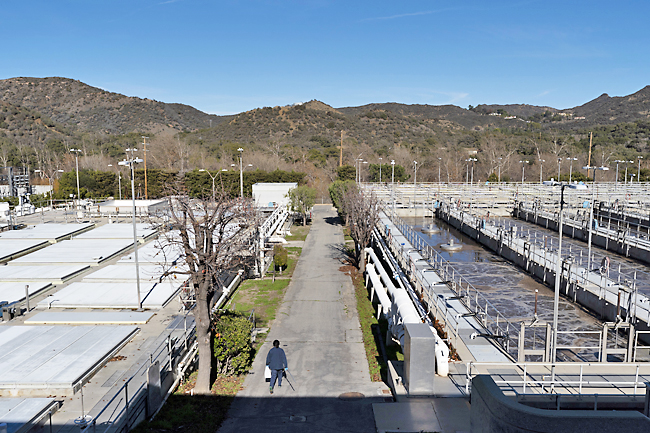Kathleen Ronayne
AP – In a wealthy enclave along the Santa Monica Mountains that is a haven for celebrities, residents are now facing more aggressive consequences for wasting water.
The Las Virgenes Municipal Water District northwest of Los Angeles hopes to spur water savings by making it easier to fine households that go over their allotted “water budgets” and threatening to vastly limit water flow to customers who repeatedly fail to conserve.
The district offers a bold example of how local authorities across drought-stricken California are trying to get people to use less water, voluntarily if possible but with the threat of punishment if they don’t comply. Las Virgenes officials hope their approach will be a wakeup call for residents of the affluent neighbourhoods, where most of the water goes toward outdoor use like landscaping and pools.
“What we’re trying to do is conserve water now so that we can stretch the limited supplies we have available,” said district’s general manager Dave Pederson.
California is feeling the effects of climate change; it has had drought conditions for most of the last decade and during that period endured its most destructive and deadly wildfires. After two exceptionally dry years that left the state’s reservoirs at or near record lows, a string of recent winter storms improved conditions. But most of the state is still in severe drought.


In July, Democratic Governor Gavin Newsom asked residents to voluntarily cut 15 per cent of their water use, but it declined only six per cent as of November. The state water board last month imposed a series of mild restrictions, such as waiting two days after a storm to water lawns. It could take more significant steps later in the year if the drought intensifies.
In California, local districts provide water service, regulate use and enforce penalties. Las Virgenes serves about 75,000 people in Agoura Hills, Westlake Village, Calabasas and Hidden Hills, an area that in recent years has attracted a growing number of celebrities, including Kim Kardashian and Will Smith.
Like much of inland Southern California, Las Virgenes rarely sees rain outside the winter months, and during summer the average high temperature is in the mid-90s Fahrenheit. It’s wealthier than most places – a typical home in Calabasas sells for more than USD1.5 million, according to the online real estate marketplace Zillow.
Despite calls for conservation, water customers there increased use in August and September, then exceeded the 15-per-cent reduction goal in October before again missing the target in November. Collectively, customers greatly exceeded their water budgets last year.
One of the district’s biggest issues is “the ability for affluent customers to significantly exceed their water budgets consistently since money is not a deterrent”, said district’s spokesman Michael McNutt. He declined to share the names of the district’s biggest water users.
About 70 per cent of water in the district goes to outdoor uses, and many are willing to pay a higher water bill to keep their lawns and gardens lush and pools filled.
“It appears there has been a lackluster response to the water emergency,” said Calabasas Mayor Mary Sue Maurer, who thinks restricting water flow could provide the wakeup call some people need.
Due to dry conditions, California regulators said in December they would not provide any water from state supplies beyond what was needed for essentials like drinking and bathing. That could change in the coming months, but allocations likely won’t go up significantly unless it’s a very wet winter. The uncertainty is particularly stressful for Las Virgenes, which gets about 80 per cent of its water from state supplies.
The district’s new approach to spur conservation is part carrot, part stick:
The agency is installing an advanced water metering system that will show customers in real time how much water they’re using. It’s designed to help people spot when they are exceeding the limit and adjust their behaviour, rather than waiting until the monthly bill arrives to realise they overused. They’ll be installed district-wide by April except for customers who opt out, which few have done.
Every household has a “water budget”, something used by many California water districts, based on the number of residents and property size. Starting this month, customers will face fines if they go 150 per cent over their monthly budget.
Previously, the fine threshold kicked in at 200 per cent, and about 15 per cent of the district’s customers were fined, Pederson said. People get only a warning the first time they go over budget.
But fines aren’t the harshest penalty; households fined three times could have a flow restrictor put on their water system, slowing what comes out of their faucets or hoses to a trickle. Previously, the district could add the restrictors after five fines but never did.
Richer Californians did not conserve as much as others during the last drought even when the state mandated it, said assistant professor at the University of California, Riverside Mehdi Nemati.
Las Virgenes’ approach of advanced metering, fines and the threat of flow restrictors, stands out among the state’s more than 400 medium to large water agencies, he said.
Only a few dozen districts have the advanced metering systems because they are expensive to install, and few use penalties against residents who overuse.
Instead, many districts increase the cost of water as customers use more.







